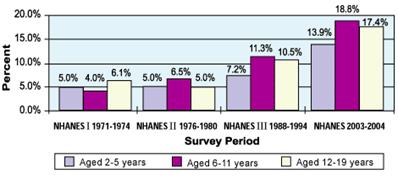The Facts
Currently, in the
Prevalence of Overweight* Among US Children and Adolescents (Aged 2-19 Years)
National Health and Nutrition Examination Surveys

In the health and fitness industry, personal fitness trainers need to have a solid understanding of their role in combating this alarming trend. Research has shown that there is a direct correlation between a person being overweight and developing a dangerous condition known as metabolic syndrome. Forty-seven million people (more than one in five Americans, according to US census data in 2000) have been clinically diagnosed with metabolic syndrome. That number today is believed to be between 60 to 70 million, and the number of people with metabolic syndrome continues to increase with age, affecting more than 40% of people in their 60s and 70s.
What Is Metabolic Syndrome?
Metabolic syndrome is a grouping of risk factors that significantly increase an individual�s risk of developing cardiovascular disease, stroke or diabetes. The primary abnormality present in metabolic syndrome is insulin resistance. Insulin levels become elevated when the body attempts to overcome its resistance to insulin. The elevated insulin levels lead, directly or indirectly, to the other metabolic abnormalities. The metabolic syndrome has been called the �silent killer� because many Americans are potentially affected but do not know it. Unfortunately, the only symptom specifically associated to this syndrome is abdominal obesity. A person is diagnosed as having metabolic syndrome if they have at least three of the following five cardiovascular disease risk factors:
1. Being overweight, specifically in the abdominal region � BMI of 27.3% or more for women and 27.8% or more for men; waist circumference greater than 35 inches in women and 40 inches in men.
2. High triglyceride level in the blood � serum triglyceride level of 150 mg/dL or higher.
3. Having a lower than normal level of HDL cholesterol � HDL (high-density lipoprotein) less than 50 mg/dL for women and 40 mg/dL for men.
4. Elevated blood pressure � blood pressure of 130/85 mm Hg or higher
5. High fasting blood sugar level � fasting glucose level of 110 mg/dL or higher
The Personal Trainer�s Role
Millions of Americans who are at risk for metabolic syndrome can lower their chances of getting this disease by adopting a healthy lifestyle. Two of the most important factors in preventing or delaying metabolic syndrome are increasing one�s physical activity and eating a healthy balanced diet. Not surprisingly, these are also the most effective methods to reverse insulin resistance.
Personal fitness trainers can help their clients by teaching them strategies to become more active and make better dietary choices. A study by the Diabetes Prevention Program found that losing eight to 10 pounds and walking briskly for 150 minutes per week reduced the risk of getting diabetes by 58%. A person who is overweight and out of shape may find it difficult to achieve the appropriate amount of activity that is necessary to reduce their risk of developing metabolic syndrome. It is important to note that doing some exercise is better than none, and personal trainers need to encourage their clients to set aside 20 to 30 minutes each day to �move their body.� Working with a qualified personal fitness trainer can greatly increase an individual�s success rate by having a personalized program that is designed to their specific level of fitness. It will take time and discipline to appreciate the results achieved through exercise, and the trainer/client relationship is critical for accountability and ultimate success.
Resistance training not only offers an individual the benefits of increased muscle strength and endurance, it generally increases the discomfort threshold associated with moderate to vigorous exercise. One study in The American Journal of Cardiology compared how different exercise intensities decreased the risks associated with metabolic syndrome. The results suggest that moderate intensity activity every day or almost every day may be better for metabolic syndrome risk reduction than more vigorous activity a few days a week. Personal fitness trainers need to remember to gradually increase the intensity of their clients� programs to reduce the risk of injury.
No single diet is currently recommended for individuals with metabolic syndrome; therefore, personal trainers should attempt to focus on each client�s specific situation when offering dietary advice. Most professionals agree that there needs to be a focus on decreasing caloric intake by reducing portion sizes to improve metabolic syndrome abnormalities. Specific dietary changes may include reducing saturated fat intake to lower insulin resistance, reducing sodium intake to lower blood pressure and reducing high-glycemic-index carbohydrate intake to lower triglyceride levels. A diet that includes more fruits, vegetables, whole grains, monounsaturated fats and low-fat dairy products will benefit most people with metabolic syndrome.
As health and fitness professionals, we have the ability to make a significant difference in decreasing the prevalence of metabolic syndrome in the
Dan Agresti, MS, HFI, received his Master�s Degree in Kinesiology and Applied Physiology from the









